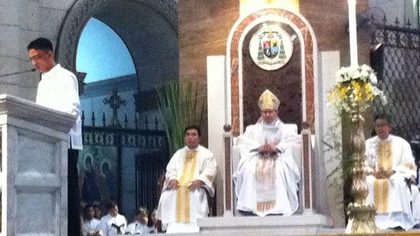SUMMARY
This is AI generated summarization, which may have errors. For context, always refer to the full article.

MANILA, Philippines – The historic Manila Cathedral, which Catholic Church authorities have closed for structural repairs until 2013, joins other religious structures that urgently need fortification against earthquakes, based on recent warnings from state seismologists.
Citing concerns about the cathedral’s structural integrity, Manila Archbishop Luis Antonio Tagle announced on Monday, February 13, the closure of the Manila Cathedral starting February 7.
The closure will affect about 200 couples who have made reservations up to March 2013 at one of the country’s favorite venues for wedding rites.
Following the magnitude-6.9 earthquake that totally damaged at least 2 churches in the Visayas, the Philippine Institute of Volcanology and Seismology (Phivolcs) also warned other historical churches to prepare for earthquakes.
Phivolcs associate scientist Leonila Bautista said the National Commission for Culture and the Arts, for one, should do the needed renovations as soon as possible, according to an article on the Catholic Bishops’ Conference of the Philippines website.
“It’s a race against time,” Bautista said. “I hope they will do it fast.”

3 items of ‘greatest concern’
In a circular earlier in February, Tagle enumerated 3 items of “greatest concern” regarding the cathedral’s structural integrity – factors that other Philippine churches and similar structures can take their cue from.
- Incapacity of the soil to bear the structure’s weight. The deficiency in its soil bearing capacity is at two-thirds the required levels, Tagle said. “This in itself presents unsafe conditions even in normal circumstances given that the whole structure is held up by the soil,” said a Manila Archdiocese statement.
- Presence of “potentially liquefiable soil materials.” A mass of soil can lose a large percentage of its bearing capacity “when subjected to monotonic, cyclic, or shock loading, as in an earthquake, and flows in a manner resembling a liquid,” the archdiocese said. “Much of the damage on substructures and (foundations) during a seismic event is attributed to this phenomenon.”
- Failure of twin columns at the center of the Manila Cathedral to meet design standards
The Manila Archdiocese has designated a temporary “official church” in the meantime.
Earthquakes have destroyed the Manila Cathedral, which has also been reconstructed several times, throughout its 4-century history. –Rappler.com
Add a comment
How does this make you feel?
There are no comments yet. Add your comment to start the conversation.